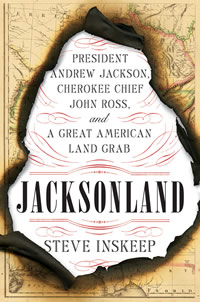Prologue to Tragedy
Steve Inskeep casts new light on the ideas of land ownership that led to the Trail of Tears
In Jacksonland: Andrew Jackson, Cherokee Chief John Ross, and a Great American Land Grab, Steve Inskeep uses the investigative skills that earned him an Edward R. Murrow award in journalism to produce a compelling study of the interwoven lives of Jackson and Ross, as well as the struggle over land—“whiteland,” “Indian land,” and eventually “Jacksonland”—that played out between whites and Native Americans during the nineteenth century. Andrew Jackson, Inskeep writes, “strove to make the map his own.”
 Jacksonland, in other words, is a story of manifest destiny, before the phrase gained popularity, as white settlers claimed land they deemed theirs by right of providence. It is a story of conquest, as white soldiers (often assisted by Native American allies) fought and displaced native populations to secure the land for those settlers. For the Creek, Seminole, Cherokee, and others, it is also a story of survival, as Native Americans across the South exhausted every possible method and means of retaining and remaining on their land, all to no avail.
Jacksonland, in other words, is a story of manifest destiny, before the phrase gained popularity, as white settlers claimed land they deemed theirs by right of providence. It is a story of conquest, as white soldiers (often assisted by Native American allies) fought and displaced native populations to secure the land for those settlers. For the Creek, Seminole, Cherokee, and others, it is also a story of survival, as Native Americans across the South exhausted every possible method and means of retaining and remaining on their land, all to no avail.
Inskeep’s work is well researched and documented. Beginning with the adventures of John Ross and three companions traveling west on the Tennessee River in 1812, this masterly-woven narrative captures the reader’s attention on the first page and holds it to the end: the 1838 forced migration of the Cherokee to the West, a journey now known as the Trail of Tears. Along the way, Inskeep develops the relationships of Jackson, Ross, and a multitude of familiar characters—Henry Clay, Major Ridge, and Chief Justice John Marshall among them. He also introduces lesser-known but equally important figures in the South’s nineteenth-century “land-grab”: missionary Samuel Worcester, for whom a Supreme Court case was named, for example, and Elias Boudinot, publisher of the first Native American newspaper, the Cherokee Phoenix.
While Jacksonland culminates with the story of the Trail of Tears, the removal itself is but a small part of a much larger story that includes the connected lives of Andrew Jackson and John Ross, who joined forces in the 1814 Battle of Horseshoe Bend to defeat the “Red Sticks,” members of the Creek blamed for the massacre of white settlers. Through brief biographical sketches placed strategically throughout the book, Inskeep reveals the similarities between the two men and the parallel paths they often walked. He discusses the circumstances that allowed Jackson, orphaned during the American Revolution, to read for the law and establish himself in Nashville, the fastest-growing of America’s frontier cities. Likewise, he sheds light on the matrilineal traditions of the Cherokee and explains how Ross, with just one full-blooded Cherokee great-grandmother, rose to leadership. Jacksonland reveals the importance of 1828 to both men—that year marks Jackson’s election as seventh president of the United States and Ross’s as principal chief of the Cherokee—and the adversaries they faced during their leadership terms.
 Tensions grew between a Cherokee population that desired statehood, including right to the land they had inhabited for generations, and a U.S. government which had concluded that the only future—indeed, the only chance of survival—for America’s Native American population was removal from regions of white habitation and resettlement in the West, where they might carry on their traditions and culture. In describing the Cherokee homes, farms, plantations, and industries, and their adoption of western styles of dress and deportment, Inskeep reveals that these were not the hunters and gatherers of generations past. As he makes clear, the federal government was either unaware of the 1830s practices of the Cherokee or simply unwilling to accept them as equal citizens of the United States.
Tensions grew between a Cherokee population that desired statehood, including right to the land they had inhabited for generations, and a U.S. government which had concluded that the only future—indeed, the only chance of survival—for America’s Native American population was removal from regions of white habitation and resettlement in the West, where they might carry on their traditions and culture. In describing the Cherokee homes, farms, plantations, and industries, and their adoption of western styles of dress and deportment, Inskeep reveals that these were not the hunters and gatherers of generations past. As he makes clear, the federal government was either unaware of the 1830s practices of the Cherokee or simply unwilling to accept them as equal citizens of the United States.
Of particular value are Inskeep’s discussions of relevant cases heard by the U.S. Supreme Court and the details behind the Cherokee’s forced march to the West. In 1832, the Marshall Court found in favor of the Cherokee in Worcester v. Georgia and declared as unconstitutional a Georgia state law which had led to the arrest and imprisonment of missionaries living and working among the Cherokee, Samuel Worcester among them. The decision required action by the state, which Georgia did not take, and enforcement by the Executive Branch, which was not forthcoming. As Inskeep explains, the court did its job, but Georgia and Jackson failed to do theirs.
Native American removal was a foregone conclusion by the late 1830s. In the spring of 1837, with Jackson out of office, John Ross knew removal was imminent but hoped to secure better terms for his people. As those negotiations continued in Washington, General Winfield Scott prepared for the Cherokee relocation. A communique dispatched from Washington on May 23, 1838, the deadline for removal, advised Scott to delay—new arrangements would allow Ross to orchestrate the relocation of his own people—but the orders did not reach Scott in time. As Inskeep makes clear, the forced military removal of the Cherokee did not have to occur.
At a time when casual bookstore browsers might wonder if yet another Andrew Jackson book is needed, Jacksonland provides clear evidence of a resounding “yes.” Inskeep fairly and objectively addresses the most important aspect of Andrew Jackson’s long and illustrious career: his relationship with John Ross and his dealings with the Cherokee over the land—Jacksonland.

Brenda Jackson-Abernathy chairs the history department at Belmont University in Nashville. She has published widely on U.S. history during the eighteenth and nineteenth centuries, including Jacksonian America and the Civil War.


